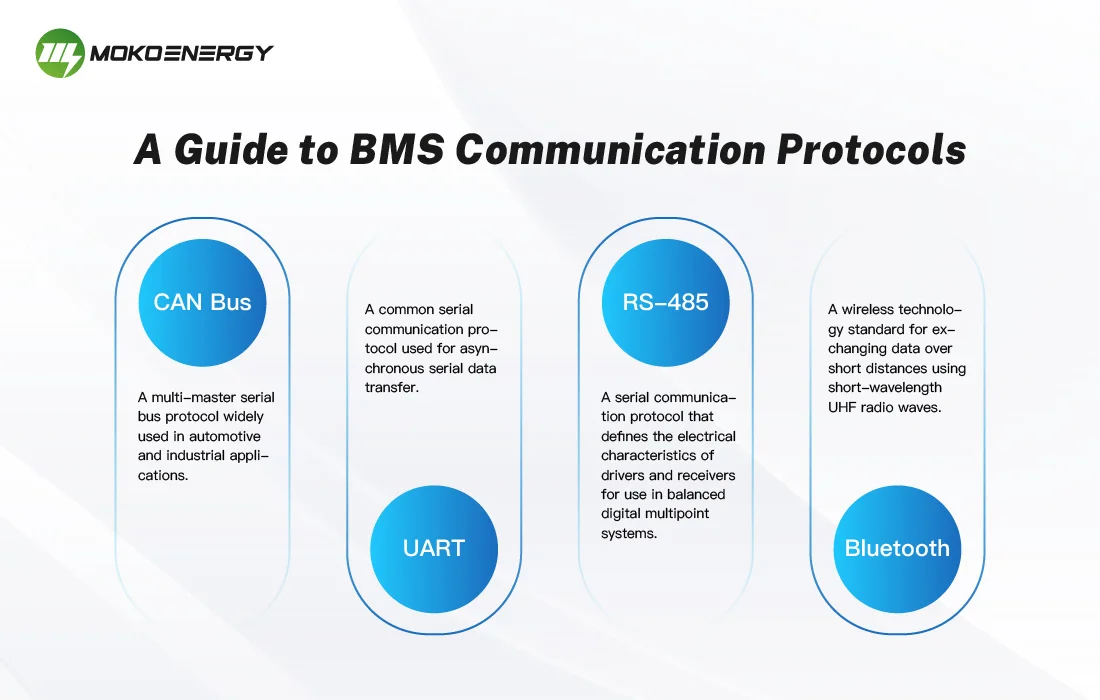In the past decade, battery-powered applications have become widespread, necessitating safety measures for their secure usage. To ensure the safety and dependability of batteries in various applications like electric vehicles, renewable energy storage, and portable devices, battery management systems (BMS) play a crucial role. The BMS monitors and regulates voltage, current, temperature, and state of charge for each cell or module in a battery pack while performing functions like balancing, protection, communication, and diagnostics. However, creating and testing a robust BMS is a complex endeavor, involving numerous challenges and trade-offs. In this article, we will explore key aspects of BMS design and testing, the challenges it presents, and highlight exceptional features of the MOKOEnergy products.
Why the Efficient BMS Design is Important for Your Project?
Designing an efficient BMS is critical not only from a safety point of view but also for customer satisfaction. Here are several key functions and benefits:
Precise Monitoring and Control: The BMS continuously monitors the voltage, current, and temperature of each battery cell. It uses this data to calculate the state of charge and state of health, enabling precise control over charging and discharging processes to prevent battery damage and ensure efficient operation.
Cell Balancing: A well-designed BMS implements cell balancing techniques to address variations in cell capacities and voltages. Cell balancing guarantees that all cells receive equal charge and discharge, maximizing the overall capacity utilization and prolonging the battery’s longevity.
Protection Mechanisms: The BMS incorporates protection circuits to safeguard against overcharging, over-discharging, excessive temperatures, and short circuits. These protection mechanisms prevent catastrophic failures and ensure the safety of the battery and the surrounding environment.
Communication and Integration: An efficient BMS supports various communication protocols, allowing seamless integration with other system components, such as energy management systems or microcontrollers. This enables real-time data exchange and remote monitoring and control.
Enhanced Battery Performance: By precisely managing the battery’s state of charge and preventing harmful conditions, an efficient BMS design enhances the battery’s overall performance, leading to improved energy efficiency and longer cycle life.

What Should You Consider Before Designing BMS Hardware and Software?
Hardware
Voltage and Current Sensing: Accurate voltage and current sensing are crucial for monitoring the state of charge, state of health, and overall battery performance. The BMS hardware should include high-precision voltage and current sensors or measurement circuits to provide reliable data.
Temperature Sensing: Temperature monitoring is essential for battery safety and longevity. The BMS hardware should incorporate temperature sensors to measure the cell and ambient temperatures accurately.
Protection Circuitry: Robust protection circuitry is critical to prevent hazardous situations such as overcharging, over-discharging, and short circuits. The hardware components must incorporate high-current fuses, overcurrent protection circuits, and overvoltage protection circuits.
Cell Balancing Circuitry: Cell balancing is essential to maintain uniform cell voltages and capacity levels within the battery pack. The BMS hardware should include efficient balancing circuits or techniques to redistribute charge among cells.
Communication Interfaces: The BMS hardware should support various communication protocols, such as CAN, RS485, or Modbus, to facilitate data exchange with other system components and enable real-time monitoring and control.
Microcontroller and Processing Unit: The microcontroller or processing unit is the brain of the BMS. It should have sufficient processing power and memory to handle the complex algorithms and tasks required for battery monitoring and control.
Redundancy and Fault Tolerance: In critical applications, BMS hardware should include redundancy and fault tolerance features. Redundant sensors, processing units, and communication interfaces can provide backup in case of component failures.
EMC and EMI Considerations: Electromagnetic compatibility (EMC) and electromagnetic interference (EMI) are crucial for reliable BMS operation. The hardware design should incorporate shielding and filtering to minimize EMI/EMC issues.
Software
Control Algorithms: Develop advanced control algorithms for charge and discharge management, cell balancing, and state-of-charge estimation. Consider adaptive algorithms to handle varying battery characteristics.
Real-Time Responsiveness: Ensure the BMS software can make real-time decisions to optimize battery performance and safety.
SOC Estimation Accuracy: Use accurate and reliable algorithms for State-of-Charge (SOC) estimation to prevent overcharging or over-discharging and maximize battery utilization.
Fault Detection and Diagnostics: Implement algorithms for fault detection and diagnostics to identify and respond to abnormal battery conditions promptly.
Firmware Updates: Enable firmware update capabilities to keep the BMS up-to-date with the latest advancements and improvements.
Explore the BMS Design Process
The BMS design process is a systematic approach to developing a Battery Management System that meets the specific requirements of an energy storage system. It involves a series of steps, from defining system specifications to the final implementation and testing. Below are the key steps in the BMS design process:
| Step | Description |
| 1. Requirements Gathering | Gather and define the requirements for the BMS. This involves understanding the application’s needs, the battery chemistry, cell configuration, voltage and current ratings, temperature range, safety regulations, communication interfaces, and any other specific functionalities required. |
| 2. System Architecture and Component Selection | Based on the gathered requirements, the BMS’s system architecture is determined. This involves selecting the appropriate microcontrollers, sensors, switches, power management ICs, and communication modules. Component selection is critical as it directly impacts the BMS’s performance and efficiency. |
| 3. Cell Monitoring and Protection Circuitry Design | The BMS must incorporate precise cell monitoring and protection circuitry to monitor individual cell voltages, currents, and temperatures. This circuitry guarantees precise data acquisition and safeguards the battery against overcharging, over-discharging, and other potential dangers. |
| 4. Voltage and Current Sensing Techniques | Accurate voltage and current sensing are essential for monitoring the state of charge, determining the battery’s performance, and controlling the charging and discharging rates. The BMS employs sensing techniques such as shunt resistors, Hall-effect sensors, or current transformers for precise measurements. |
| 5. Temperature Monitoring and Thermal Management Strategies | Temperature monitoring is critical for battery safety and longevity. The BMS includes temperature sensors to monitor cell temperatures and implements thermal management strategies like cooling or heating to maintain optimal operating conditions. |
| 6. Cell Balancing and Equalization Methods | To maximize battery pack capacity utilization and lifespan, the BMS implements cell balancing and equalization techniques. These methods redistribute charge among cells, ensuring they remain balanced regarding voltage and capacity. |
| 7. Communication Protocols and Integration | The BMS should support standard communication protocols such as CAN, RS485, or Modbus for seamless integration with other system components. It facilitates the sharing of information, real-time monitoring, and regulation with energy management systems, chargers, or other equipment. |
| 8. BMS Software Development | The BMS software is developed to handle data processing, control algorithms, fault detection, and communication. Advanced algorithms are implemented to optimize battery management, ensure safety, and enhance overall performance. |
| 9. Testing and Validation | Comprehensive testing and validation are critical to ensure the BMS functions as intended. This involves testing each component, verifying control algorithms, performing simulation tests, and validating the BMS’s performance under various operating conditions and safety scenarios. |
| 10. Optimization and Refinement | After testing, the BMS may undergo further optimization and refinement. This step involves fine-tuning algorithms, improving efficiency, and addressing any identified issues or limitations. |
| 11. Integration and Deployment | Once the BMS design is finalized and validated, it is integrated into the energy storage system and deployed for real-world applications. During integration, compatibility and communication with other system components are verified. |
| 12. Maintenance and Upgrades | BMS design is an ongoing process. Regular maintenance and firmware/software upgrades are essential to keep the BMS up-to-date with changing battery characteristics, evolving requirements, and advancements in battery management technologies. |

Challenges You May Face During BMS Design
Designing a Battery Management System comes with its own set of challenges due to the complexity and critical nature of its role in energy storage systems. Some common challenges include:
Safety
Ensuring the highest level of safety is paramount in BMS design. It involves implementing robust protection mechanisms and fail-safe measures to prevent hazardous conditions like overcharging, over-discharging, and thermal runaway.
Cell Balancing
Battery packs containing one to four batteries connected in parallel and three or more batteries connected in series experience the most significant advantage of cell balancing. When multiple batteries are connected in parallel per cell, the performance of weaker cells is averaged with other cells in parallel, resulting in a narrower performance distribution among cells. However, as the number of cells in parallel increases, it becomes more challenging to identify the weaker cell within the battery pack. This can lead to inefficient battery usage, where a battery pack at rest may continue to lose charge as stronger cells try to compensate for the weaker cell.
Temperature
Maintaining optimal battery temperatures is crucial for performance and safety. BMS design should incorporate effective thermal management strategies to prevent overheating or overcooling of the battery cells. Nevertheless, obtaining the most accurate temperature measurement is one of the most challenging aspects of BMS design. It involves considering the pros and cons of different sensor types (such as fully digital interface or analog) and determining the optimal location for measuring the battery pack’s temperature.
Battery Compatibility
Different battery chemistries have unique charging and discharging characteristics. Designing a versatile BMS that is compatible with various battery types and can handle different voltage and capacity ranges can be challenging.
MOKOEnergy’s Custom BMS Solution
For experts, designing a Battery Management System is a common engineering task, and there are no apparent issues. That’s why the skill level of the development team is crucial in BMS design. To attain the intended outcomes, it is imperative to entrust your project to authentic specialists. This is where MOKOEnergy comes in; we have extensive experience in various rechargeable batteries, a wide range of voltages, and power levels. Our engineers have created simple to complex BMS designs for numerous applications, from small consumer devices to large-scale energy storage solutions. While facing some challenges during the BMS design process, our real-world examples at MOKOEnergy demonstrate the high performance, enhanced safety, and extended battery life of our BMS products.
Some successful BMS designs by MOKOEnergy include:
- Electric Vehicle BMS with advanced algorithms for optimized driving range, battery life, and reliable performance.
- Renewable Energy Storage BMS for precise charging/discharging control, voltage balancing, and thermal management, contributing to grid stability.
- Industrial Energy Backup BMS ensures uninterrupted power supply, fault protection, and enhanced safety.
- Portable Medical Device BMS for accurate battery monitoring and continuous functionality in critical situations.
- Marine and Off-Grid BMS with robust communication protocols for remote monitoring and control, optimizing battery performance and reducing downtime.

Conclusion
BMS monitors the battery pack to protect the batteries and the entire system. A subpar BMS not only compromises the system’s safety but also provides inaccurate Battery SOC management. These inaccuracies have a significant impact on the final product’s quality, potentially leading to hazardous failures or negative user experiences. To address these issues, we explain more about the workings and design principles of Battery Management Systems. We also highlight the critical features of MOKOEnergy‘s products and a range of energy storage solutions, from small consumer devices to large-scale applications. Whether you’re interested in creating a BMS for high-power applications or simpler devices, please contact us directly for more information!
CONTINUE READING ABOUT THE BATTERY MANAGEMENT SYSTEM ARCHITECTURE








